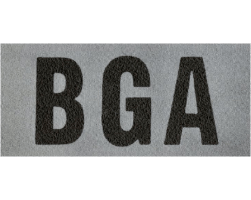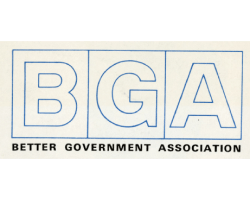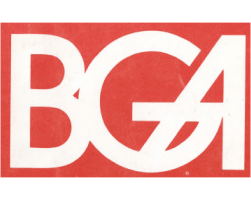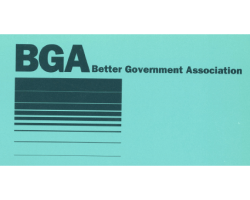For nearly 100 years, the Better Government Association has fought corruption, waste, secrecy and inequity by shining a spotlight on the workings of government in Illinois.






The BGA was founded in 1923 by a small group of clergymen, lawyers and businessmen. The founders believed that “public officials under close scrutiny would serve the public better; that the best voter was an informed one and the best citizen was an involved one.”
In the mid–1950s, that scrutiny began to take the form of investigative reporting, leading to some of the most significant journalistic exposés published in Illinois.
Today, the BGA has grown to comprise nine investigative journalists. With growing expertise in data journalism, this team digs in deeply to access and analyze public records, revealing stories and connections that legacy media no longer have the time and resources to pursue.
Under the leadership of President and CEO David Greising, today the BGA also proudly claims an active policy team that advocates for more fair and efficient government through reforms. We fight for transparency by testifying and filing suit to protect and enforce open meetings laws and win access to public records.
Through civic engagement and community building, we also work to inform and engage citizens, equipping them with information, techniques and tools to demand government accountability.
The 1920s–1950s: The BGA’s Beginnings
The BGA came to life in the Prohibition Era. Alcohol was illegal yet more than 5,000 taverns and speakeasies thrived. City aldermen, who won their votes through fraud and ballot-box stuffing, ran illegal gambling houses and brothels. Chicago Mayor William “Big Bill” Thompson — known as one of the worst mayors of any major city at any time in the country’s history — was openly in cahoots with the infamous Al Capone mob.
In May of 1923, a small group of clergymen, lawyers, editors and businessmen, under the guidance of E.J. Davis, director of the Anti-Saloon League, formed the Better Government Association to fight corruption by exposing wrongdoing while informing and engaging voters.
In 1957, new Executive Director George Mahin began to shift the role of the BGA, adopting a policy that emphasized investigative journalism.
The 1960s: Operation Watchdog
In 1961, Mahin and Charles Percy, a board member, launched a new program called Operation Watchdog. This allowed any reporter in town who was investigating government waste or corruption to come to the BGA for help. These media partners benefitted from extra shoe-leather reporting from the BGA, while the reporter’s newspaper or television station would get the first crack at the story.
These inspired partnerships put unprecedented pressure on local and state politicians and public officials. It all started with Chicago Tribune reporter George Bliss.






BGA Investigation No. 1
In 1962, Chicago Tribune reporter George Bliss worked with BGA investigators to uncover massive corruption at the Metropolitan Sanitary District. The investigation was a huge success, forcing the firing of corrupt employees and the resignation of their political bosses. The investigations rocked Chicago’s infamous political machine.
By 1969, the BGA had revealed massive vote-stealing, election fraud, ambulance shortages, nursing home abuses and numerous instances of tax-gobbling waste and fraud. After producing a number of award-winning stories as a media partner, George Bliss joined the BGA as an employee. He was the BGA’s chief investigator through Mahin’s retirement, through Richard Friedman’s brief tenure as executive director (1969 – 1971) and into J. Terrence Brunner’s first years at the BGA. Bliss returned to the Tribune in 1972, as the head of a special investigative task force.
The 1970s: Awards and Angry Officials
By the time J. Terrence Brunner took over leadership of the BGA in 1971, the organization had earned a national reputation for its powerful investigations and had helped its media partners win two Pulitzer Prizes along with countless other journalism awards.
Soon after Brunner’s arrival, the BGA exposed election corruption in Mayor Richard J. Daley’s political machine, winning the Chicago Tribune another Pulitzer and causing Mayor Daley to accuse the BGA of being “an arm of the Republican Party.”
Under Brunner’s guidance, the BGA again expanded its focus and raised its profile, partnering with local and national TV media. The BGA continued its work with the Chicago Tribune, Chicago Sun-Times and Daily News, but also began to work with national news magazines such as CBS’ 60 Minutes, and ABC News’ 20/20.
The Mirage Tavern Investigation
In 1977, the BGA partnered with CBS’ 60 Minutes and the Chicago Sun-Times on an unprecedented, elaborate undercover investigation running out of a tavern in Chicago’s Old Town neighborhood.
Using aliases, the BGA and the Sun-Times actually purchased a run-down tavern, and put cameras in the wall, named it The Mirage, and opened for business. The cameras recorded what became a parade of bribe-seeking inspectors and employees. The incendiary investigation caused a national sensation, a spate of firings and new reforms.
In 1979, the BGA opened offices in Washington, D.C., and Springfield, Ill., to expose corruption at state and national levels. Though the program was extremely successful — producing more than 20 hard-hitting investigations in just five years — it was too expensive to maintain. The D.C. office was closed in 1984.
In addition to expanding the organization’s reach and profile, Brunner expanded the BGA’s capacity to push for reform. He developed a top-flight legal program and a nationally recognized investigative internship program, which has trained hundreds of future lawyers, journalists and civic activists.
The 1980s–1990s
The BGA continued to make local and national news with deep, dogged investigations. BGA reporters exposed fraud in the Chicago Public Schools, which led to reforms of the whole school system, and uncovered lax security at O’Hare International Airport. BGA investigations into local police departments led to reforms that resulted in the formation of multi-jurisdictional task forces in Illinois.
As early as 1982, the BGA was investigating George Ryan, then-Speaker of the Illinois House, over the use of his influence to protect a nursing home facing state charges —and in doing so, regain business for Ryan’s Kankakee pharmacy.
Investigations continued into Ryan’s fundraising practices during his tenure as Secretary of State. He raised campaign cash from sources that he also regulated and pressured his employees to raise money for his campaign. Under Ryan, the office was also accused of taking bribes to grant licenses to unqualified truck drivers.
The New Millennium
In the new millennium, the BGA exposed a network of insiders who were obtaining concession contracts at O’Hare. The most notable recipient was Oscar D’Angelo, a disbarred attorney who worked as an unregistered lobbyist to broker the deals. D’Angelo was also a close friend to Mayor Richard M. Daley.
As a result of this investigation, the city revamped Chicago’s lobbyist ordinance to tighten its lobbyist registration requirements.
After nearly 30 years as executive director, Brunner retired in 2000, and former BGA General Counsel Terrance Norton took the helm. Under Norton’s watch, the BGA expanded its ongoing investigations into George Ryan’s fundraising practices; released a comprehensive nursing home guide, and compiled the BGA Integrity Index, the nation’s first comprehensive analysis and ranking of government transparency and accountability laws across the 50 states. Published in the fall of 2002, the index received nationwide coverage and spurred states to improve their laws. In 2003, Sue Walker replaced Norton as executive director in an interim capacity. During a time in which many nonprofit organizations faced overwhelming fundraising challenges, Walker sustained the BGA’s mission and kept the doors open. In 2004, former BGA staff attorney Jay Stewart became the new executive director.




2004–2008: Following the Money
Shortly after Jay Stewart’s arrival, the BGA recruited new staff, hiring its first chief investigator in many years. Grants were secured from the Richard H. Driehaus Foundation and the Nathan Cummings Foundation and under the leadership of Dan Sprehe, the BGA’s landmark investigative program was revived. Valuable media partnerships were re-established.
In the spring of 2005, the BGA participated in a joint investigation with the Residents Journal, revealing Chicago Housing Authority (CHA) contractors had contributed more than $250,000 to the 17th Ward Democratic Organization, a political committee in the ward where CHA CEO Terry Peterson formerly served as alderman and committeeman.
While investigating the campaign contributions to the 17th Ward Democratic Organization, the BGA discovered numerous donations from what appeared to be 501(c)(3) tax-exempt organizations.
Upon further investigation, the BGA found that more than 400 political contributions from such organizations had been given in Illinois since 1999. Although there is no law preventing candidates and campaign committees from accepting these contributions, tax-exempt organizations (under IRS tax law) are prohibited from engaging in making campaign contributions to candidates or party campaign committees. As a result of the investigation, several campaign committees returned the contributions they received from tax-exempt groups.
In the areas of policy work, the BGA worked to ensure the City of Chicago’s Public Arts Program was run in a transparent and accountable fashion. The BGA and Scott Hodes, a Chicago attorney, a founding member of Lawyers for the Creative Arts and BGA board member, filed a lawsuit against the city, alleging a history of gross mismanagement in the distribution and recording of funds for Chicago’s capital projects. The suit was settled and the city agreed to comply with the Open Meetings Act, post more information regarding the Public Art Program online and improve its financial reports.
2009–2018
In June of 2009, the BGA welcomed a new executive director, Andy Shaw, a journalist with more than 35 years’ experience covering local, state and national politics, business, education and daily news.
He believed citizens of Illinois deserve to have their faith in government restored. For Shaw, it was unacceptable to shrug and utter the old canard, “you can’t fight City Hall,” and buy into legendary Chicago alderman Paddy Bauler’s boast, “Chicago ain’t ready for reform.”
When he took the helm of the BGA, the organization was in crucial need of revitalization, down to a limited watchdog group with a staff of two. Shaw set out to aggressively rebuild the BGA.
The BGA underwent remarkable evolution and growth, focused on advancing transparency, accountability, efficiency, and honesty in state and local government. Shaw reorganized into five units: Investigations, Advocacy, Communications, Watchdog Training, and Reporting and Administration.
The BGA built strong publishing and reporting partnerships with partners such as WBEZ, Crain’s, ABC 7, CBS 2, Chicago Sun-Times, Chicago magazine, the Daily Herald, Illinois Times and the State-Journal Register. In 2017, the BGA partnered with the Associated Press on an investigation that appeared in The New York Times, Washington Post, and several other major newspapers across the country.
During his tenure, Shaw also sought to build the advocacy arm of the BGA, so as not to just expose, but also propose better policies to serve the people of Illinois. The organization filed lawsuits to force compliance with Freedom of Information Act (FOIA) requests and lobbied lawmakers to follow good-government principles when it came to reforming legislative redistricting, public pensions, Tax Increment Financing (TIF) and privatization. The organization also entered into partnerships with local universities and like-minded civic groups to support reform initiatives.
The BGA Today
In March 2018, the BGA welcomed new President and CEO David Greising, a veteran award-winning business and investigative journalist.
In recent years this team has developed significant data journalism expertise which we’ve deployed to provide valuable accountability tools: The Illinois Public Salaries Database and the Illinois Public Pensions Database allow transparency into Illinois pension systems and public salaries, so citizens can see where their tax dollars are going and understand the complexities of the fiscal future.
In 2020, a collaboration with Injustice Watch, The Chicago Reporter, DataMade and other advisers produced The Circuit, a data-driven collaboration to investigate and reveal how Cook County’s courts work. The team worked for more than a year in a massive effort to gather, organize, analyze and visualize more than 30 years of Circuit Court case records.
This data from more than 3 million cases illustrates trends in charges
since 2000 and makes it possible to scrutinize systemic inequities and
reveal biases in the fabric of the legal system that have been suspected
for generations but never definitively proven. The content
published as part of this collaboration aims to expose how
different defendants charged with similar crimes are treated.
In 2020, the BGA bolstered a strong reporting team with the addition
of David Jackson, a Pulitzer Prize-winning veteran investigative
reporter, and Sidnee King, a multimedia journalist producing stories
on government accountability with a focus on equity issues.
Recognizing that Black and Latino communities are
disproportionately affected most by failures of government, the BGA
has strengthened its commitment to diversity, equity and inclusion,
both within our workplace and through outreach and partnerships
with people in diverse communities across Chicago.
In November of 2021, the BGA announced a transformative
commitment from the Robert R. McCormick Foundation—up to $10
million over five years to launch the Illinois Solutions Partnership.
This new initiative enabled us to launch a new solutions journalism
initiative and expand our investigative staff. Ronnie Ramos, formerly
executive editor of the Indianapolis Star and founding editor of The
Daily Memphian website, joined the BGA in early 2022 as our first
editor in chief.
In May of 2022, Columbia University announced the Pulitzer Prize for
local reporting was awarded to the BGA and the Chicago Tribune, the
first Pulitzer citation in BGA history. The award honored reporting by BGA investigative reporter Madison Hopkins and the Chicago
Tribune’s Cecilia Reyes on “The Failures Before the Fires,” a series
that uncovered 61 deaths over five years in buildings where the city of
Chicago knew had prior knowledge of fire-safety issues.
Over the course of 2022, the BGA made substantial additions to staff,
hiring our first reporters focused primarily on solutions journalism,
recruiting former Chicago Sun-Times interim editor in chief Steve
Warmbir and adding prominent local journalists with an expertise in
government accountability reporting. A new audience manager began
a focus on expanded reach for all our content. The BGA policy team
scored an important success in July of 2022 by helping to draft and
pass a significant ethics reform adopted by Chicago’s City Council.
The BGA entered a new era in November of 2022 with the launch of
two new websites: Illinois Answers Project and a refashioned BGA
Policy. The Illinois Answers Project website and mobile application is
designed to showcase our investigative and solutions reporting, as well
as content created with and by partner organizations. The new BGA
Policy website presents the BGA’s incisive and potent policy advocacy
aimed at securing more transparent, equitable and accountable
government for the benefit of all people in Illinois.
In January 2024, Ruby Bailey joined the staff as the new editor in chief.

